RUBENS AND HELLENISTIC ART
Ο RUBENS ΚΑΙ Η ΕΛΛΗΝΙΣΤΙΚΗ ΤΕΧΝΗ ..
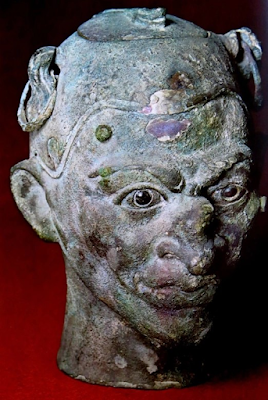 Ορειχάλκινη Αλεξανδρινή προτομή πυγμάχου (Head of a boxer, Dutuit collection)
Ορειχάλκινη Αλεξανδρινή προτομή πυγμάχου (Head of a boxer, Dutuit collection)
Χαρακτηριστικό δείγμα της Ελληνιστικής τέχνης - μάλιστα δε της Αλεξανδρινής - την οποίαν εξετίμησαν και οι Ρωμαίοι, αναθέτοντας την παραγωγή σχετικών έργων σε Έλληνες καλλιτέχνες ή σε Ρωμαίους μαθητές τους .. Βέβαια στην Πομπηία θέσιν έχουν και έργα του κλασικού ύφους .. Πρόκειται εδώ για μιά προδιάθεση της Αλεξανδρινής τέχνης να ασχοληθεί με θέματα περιθωριακά, υιοθετώντας συχνά το φυσιοκρατικό (νατουραλιστικό) ύφος και επιδιώκοντας την πρόκληση και την ενασχόληση με καθημερινά θέματα, του δρόμου κλπ...
Ο ΓΗΡΑΙΟΣ ΨΑΡΑΣ (ΡΩΜΑΪΚΟ ΑΝΤΙΓΡΑΦΟ ΕΛΛΗΝΙΣΤΙΚΟΥ ΑΡΙΣΤΟΥΡΓΗΜΑΤΟΣ, ΛΟΥΒΡΟ) - Ο ΘΝΗΣΚΩΝ ΣΕΝΕΚΑΣ ΤΟΥ RUBENS ..Bonacasa 2012, p. 153 Ο ΑΛΕΞΑΝΔΡΙΝΟΣ ΡΕΑΛΙΣΜΟΣ / ΦΥΣΙΟΚΡΑΤΙΣΜΟΣ ΖΩΝΤΑΝΟΣ ΜΙΑΜΙΣΗ ΧΙΛΙΕΤΙΑ ΑΡΓΟΤΕΡΑ ..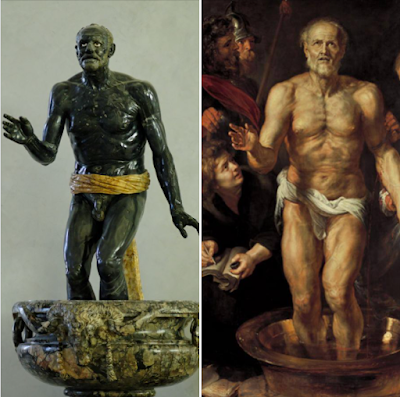 Ο Γηραιός Ψαράς[1] & Ο Θάνατος του Σενέκα[2]
Ο Γηραιός Ψαράς[1] & Ο Θάνατος του Σενέκα[2]
Σχολιασμός του Bonasaca[3]Χαρακτηριστικά Αλεξανδρινά αγάλματα: .. Ο Γηραιός Ψαράς στο Μουσείο Συντηρητών, ο Ψαράς στην Candelabra Gallery του Βατικανού,[4a] του οποίου ο τύπος επαναλαμβάνεται στο παράδειγμα από το Μουσείο Συρακουσών, ο Γηραιός Ψαράς στο Μουσείο του Λούβρου, ο οποίος χρησίμευσε ως υπόδειγμα για τον Θνήσκοντα Σενέκα του Ruhens, η Γηραιά Αγρότισσα (ή μήπως Γηραιά Εταίρα;) στο Μητροπολιτικό Μουσείο της Νέας Υόρκης,[4b] η Γηραιά Βοσκός στο Μουσείο Museo Palazzo de Conservatori,[4c] και ο Αγρότης στο Ελληνο-Ρωμαϊκό Αλεξάνδρεια. Δεν αμφισβητείται το γεγονός ότι η σίγουρα Αλεξανδρινή τυπολογία των θεμάτων του είδους διαθέτει ευαισθησία και ιδιαίτερη λεπτότητα. Αποτελεί μέρος του σύνθετου κόσμου της Αλεξάνδρειας, του κοσμοπολιτισμού της πρωτεύουσας - όπως και άλλων Ελληνιστικών κέντρων - και συχνά συνδεόταν και συγχέονταν με ανάλογα θέματα σε μικρά τεχνουργήματα χαλκού και κεραμεικής, τους γνήσιους εκπροσώπους, όπως έχουν ήδη ειπωθεί, μιας Ελληνο-Αιγυπτιακής αισθητικής που ήταν για άλλη μια φορά αυτόνομη και πρωτότυπη. Ωστόσο, η αυθεντική σημασία του Αλεξανδρινού και Ελληνο-Αιγυπτιακού ρεαλισμού ευρίσκεται στον τεράστιο πυρήνα των λεγόμενων ελασσόνων (δευτερευουσών) τεχνών, όταν αυτές παρουσιάζουν αδυσώπητα μιαν ειρωνική και μερικές φορές βάναυση διατομή της Αλεξανδρινής και της Αιγυπτιακής κοινωνίας. Έχουμε πει ότι η Ελληνιστική Αίγυπτος εκφραζόταν στον τομέα των ρεαλιστικών παρουσιάσεων με αυτόνομο και πρωτότυπο ατομικό στυλ. Αυτές είναι οι εκδηλώσεις ενός είδους ειρωνικής λαϊκής τέχνης που εμπνέεται από την καθημερινή πραγματικότητα, που του αρέσει να απεικονίζει τους απλούς ανθρώπους και τα μικρά πράγματα που τους περιβάλλουν, που αφηγείται την ιστορία της ζωής στον ποταμό, της φύσεως και των ζώων που αφθονούν σε αυτό. Τώρα εδώ, η διαδεδομένη Ελληνιστική προτίμηση για την λεπτή έρευνα συνδυάζεται με μια προτίμηση για την ανελέητη παρατήρηση του κόσμου της Αλεξανδρείας, έναν κόσμο γεμάτο με Νουβίους, Αιθίοπες, μαύρους σκλάβους, Ασιάτες, Ινδούς, καμπούρηδες, πυγμαίους, γελωτοποιούς, χορευτές, μουσικούς ,εμπόρους, πεζοπόρους, καντηλανάφτες, συλλογείς χουρμάδων, Γαλάτες, σκελετούς ή παραμορφωμένους ανθρώπους - πολλά από τα θέματα κρύβουν αριστουργήματα του αρχαίου ρεαλισμού, πάνω απ' όλα στα χάλκινα έργα, με την ζωντανή, ρεαλιστική και μερικές φορές ακόμη και τραγική ερμηνεία τους, χαρακτηριστικό το οποίο εντοπίζεται ήδη στην αρχαία Αιγυπτιακή τέχνης.
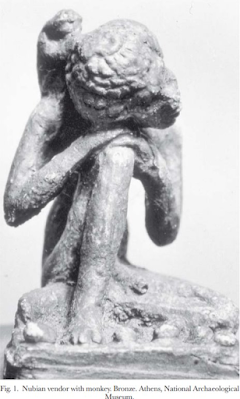 Nubian vendor with monkey (National Archaeological Museum, Athens)
Nubian vendor with monkey (National Archaeological Museum, Athens)
The Hellenistic sculpture Laocoön and His Sons was especially influential on Rubens .. His own artistic tastes were ecumenical, as can be read in his later paintings, with Titian, Michelangelo, Caravaggio and the Hellenistic sculpture in the Vatican collection being particularly influential.[5]
.. the so-called Dying Alexander, a famous Hellenistic marble bust (Galleria degli Uffizi, Florence) that exists in manycopies, and that also appears to have informed the expression of Rubens’s St. Sebastian. It seems likely that Rubens instructed his young model to pose in exactly the same position as Muziano’s St. Jerome and to adopt an expression similar to the Hellenistic prototype.[6]
Several figures mirror the classical works he studied, including the famous Hellenistic sculpture of the Crouching Venus; he would have been intimately familiar with the version of this work in the Gonzaga collection (figs. 4: Roman, Aphrodite or "Crouching Venus," second century AD, marble, 125 x 53 x 65 cm. London, The Royal Collection Trust, RCIN 69746, 5: The Fall of Phaeton, detail of crouching Hora). .. In Mantua (Lombardy] Rubens would have known the version of the Crouching Venus illustrated here (Royal Collection Trust inv. no. 69746), which was recorded in the 1627 inventory of the Gonzaga collection. Carlo d’Arco, Delle arti e degli artefici di Mantova (Mantua: D. Agazzi, 1857), 2:169; A. H. Scott-Elliot, “Statues from Mantua in the Collection of King Charles I,” The Burlington Magazine 101, no. 675 (1959): 220. SOURCE: The Conversion of Saint Paul Series at the Courtauld: Rubens’s Artistic Process Revealed by New Technical Discoveries by Clare Richardson, Kate Stonor, JHNA 13.1
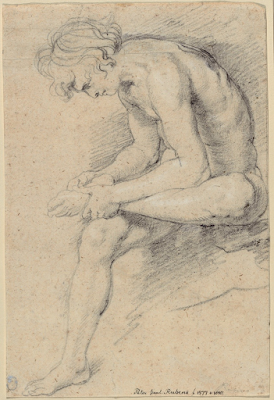 Nude Youth in the Pose of the Spinario (1610/16, Peter Paul Rubens)[8]
Nude Youth in the Pose of the Spinario (1610/16, Peter Paul Rubens)[8]
Italy, specifically ancient Roman sculpture, profoundly influenced Flemish artist Peter Paul Rubens. The artist himself wrote that “in order to attain the highest perfection in painting, it is necessary to understand the antiques … to be so thoroughly possessed of this knowledge that it may diffuse itself everywhere.”This drawing of a live studio model derives from the artist’s firsthand acquaintance with the Hellenistic bronze Spinario (also called Boy with Thorn, 1st century BCE), which was one of the most celebrated and copied sculptures in Rome. Absorbing antiquity without outright copying it, Rubens fully transformed his image from cold stone to vibrant flesh.[8]
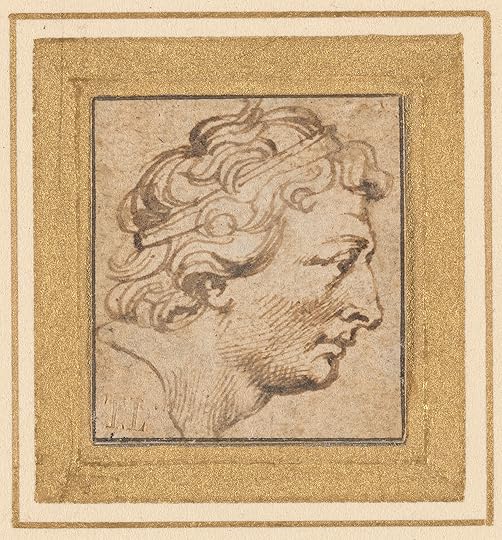 Six studies after antique Gems and Coins: Head of a Hellenistic ruler (P. R. Rubens)[10]
Six studies after antique Gems and Coins: Head of a Hellenistic ruler (P. R. Rubens)[10]
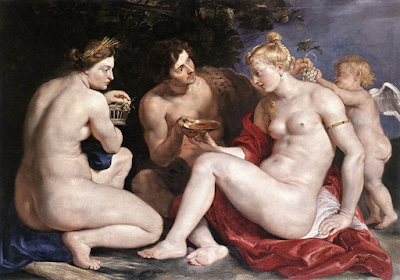 Venus, Cupid, Baccchus and Ceres (Rubens 1612/1613)[12]
Venus, Cupid, Baccchus and Ceres (Rubens 1612/1613)[12]
Rubens certainly knew the marble copy in the Farnese collection in Rome (today in the National Archaeological Museum, Naples). Rubens produced this painting a few years after his eight-year stay in Italy, where he was employed at the court of Duke Vincenzo Gonzaga of Mantua, and also in Rome. The knowledge of antiquity he gained then was put to use in this painting, as also in a later work on the same theme in 1614, (Royal Fine Arts Museum, Antwerp), Ceres' pose being taken from the Crouching Venus of the Hellenistic sculptor Doidalsas (ΔΟΙΔΑΛΣΑΣ ΒΙΘΥΝΙΟΣ), dating from around 240-230 BC. Rubens certainly knew the marble copy in the Farnese collection in Rome (today in the National Archaeological Museum, Naples).
ΣΗΜΕΙΩΣΕΙΣ
[1]. Old Fisherman Vatican-Louvre. Statue: black marble and alabaster, (modern) basin: purple breccia, Roman copy of the 2nd century after a Hellenistic original. Found in Rome (https://www.patronsvaticanmuseums.org...). [2]. The Death of Seneca (1612 - 1615). Oil on canvas. Not on display. This canvas depicts the death of the Roman philosopher Seneca, who was accused of treason and obliged by Nero to commit suicide in the year 65AD. It emphasises the values of Stoicism, an influential current of thought in early seventeenth-century Europe. The painting is a replica produced in Rubens’s studio of a work painted entirely by him now in the Alte Pinakothek, Munic.[3]. Bonacasa 2012, pp. 152-153.[4a]. https://commons.wikimedia.org/wiki/Fi.... https://www.metmuseum.org/art/collect.... https://cdn.myminifactory.com/assets/.... Prodger 2015. [6]. van Tuinen 2018, p. 46.[8]. https://www.artic.edu/artworks/202249.... https://www.themorgan.org/sites/defau.... https://el.wikipedia.org/wiki/%CE%CF%... https://www.wga.hu/frames-e.html?/htm...
ΒΙΒΛΙΟΓΡΑΦΙΑ
Prodger, M. 2015. "Rubens, Rubens, everywhere," The Guardian, <https://www.theguardian.com/artanddes... (2 July 2021).
https://www.academia.edu/43721610/Pow... Tuinen, I., ed. 2018. Power and Grace: Drawings by Rubens, Van Dyck, and Jordaens (Exhibition Catalogue, The Morgan Library & Museum, Paul Holberton Publishing.
https://www.jstor.org/stable/26476103..., N. 2012. “Labour, Handcraft and Profession in the Coroplastic Art of Graeco-Roman Egypt,” Aegyptus 92, pp. 147-156.
https://www.jstor.org/stable/872801A. H. Scott-Elliot, A. H. 1959. "The Statues from Mantua in the Collection of King Charles I," The Burlington Magazine 101 (675), pp. 218-222.
https://jhna.org/articles/rubens-the-..., C., K. Stonor. 2021. "The Conversion of Saint Paul Series at the Courtauld: Rubens's Artistic Process Revealed by New Technical Discoveries," JHNA 13 (1).
https://www.themorgan.org/drawings/it... Morgan Library and Museum.
https://www.artic.edu/artworks/202249... Institute Chicago
https://www.rct.uk/collection/69746/a... or 'Crouching Venus' Second century AD, Marble | 125 x 53 x 65 cm (whole object) | RCIN 69746
https://www.jstor.org/stable/41938349..., V. H. 1963. Rubens, Ancient Art, and the Critics," Criticism 5 (3), pp. 214-238.
ΕΜΠΛΟΥΤΙΣΜΟΣ - ΕΠΙΜΕΛΕΙΑ: 020721
 Ορειχάλκινη Αλεξανδρινή προτομή πυγμάχου (Head of a boxer, Dutuit collection)
Ορειχάλκινη Αλεξανδρινή προτομή πυγμάχου (Head of a boxer, Dutuit collection)Χαρακτηριστικό δείγμα της Ελληνιστικής τέχνης - μάλιστα δε της Αλεξανδρινής - την οποίαν εξετίμησαν και οι Ρωμαίοι, αναθέτοντας την παραγωγή σχετικών έργων σε Έλληνες καλλιτέχνες ή σε Ρωμαίους μαθητές τους .. Βέβαια στην Πομπηία θέσιν έχουν και έργα του κλασικού ύφους .. Πρόκειται εδώ για μιά προδιάθεση της Αλεξανδρινής τέχνης να ασχοληθεί με θέματα περιθωριακά, υιοθετώντας συχνά το φυσιοκρατικό (νατουραλιστικό) ύφος και επιδιώκοντας την πρόκληση και την ενασχόληση με καθημερινά θέματα, του δρόμου κλπ...
Ο ΓΗΡΑΙΟΣ ΨΑΡΑΣ (ΡΩΜΑΪΚΟ ΑΝΤΙΓΡΑΦΟ ΕΛΛΗΝΙΣΤΙΚΟΥ ΑΡΙΣΤΟΥΡΓΗΜΑΤΟΣ, ΛΟΥΒΡΟ) - Ο ΘΝΗΣΚΩΝ ΣΕΝΕΚΑΣ ΤΟΥ RUBENS ..Bonacasa 2012, p. 153 Ο ΑΛΕΞΑΝΔΡΙΝΟΣ ΡΕΑΛΙΣΜΟΣ / ΦΥΣΙΟΚΡΑΤΙΣΜΟΣ ΖΩΝΤΑΝΟΣ ΜΙΑΜΙΣΗ ΧΙΛΙΕΤΙΑ ΑΡΓΟΤΕΡΑ ..
 Ο Γηραιός Ψαράς[1] & Ο Θάνατος του Σενέκα[2]
Ο Γηραιός Ψαράς[1] & Ο Θάνατος του Σενέκα[2]Σχολιασμός του Bonasaca[3]Χαρακτηριστικά Αλεξανδρινά αγάλματα: .. Ο Γηραιός Ψαράς στο Μουσείο Συντηρητών, ο Ψαράς στην Candelabra Gallery του Βατικανού,[4a] του οποίου ο τύπος επαναλαμβάνεται στο παράδειγμα από το Μουσείο Συρακουσών, ο Γηραιός Ψαράς στο Μουσείο του Λούβρου, ο οποίος χρησίμευσε ως υπόδειγμα για τον Θνήσκοντα Σενέκα του Ruhens, η Γηραιά Αγρότισσα (ή μήπως Γηραιά Εταίρα;) στο Μητροπολιτικό Μουσείο της Νέας Υόρκης,[4b] η Γηραιά Βοσκός στο Μουσείο Museo Palazzo de Conservatori,[4c] και ο Αγρότης στο Ελληνο-Ρωμαϊκό Αλεξάνδρεια. Δεν αμφισβητείται το γεγονός ότι η σίγουρα Αλεξανδρινή τυπολογία των θεμάτων του είδους διαθέτει ευαισθησία και ιδιαίτερη λεπτότητα. Αποτελεί μέρος του σύνθετου κόσμου της Αλεξάνδρειας, του κοσμοπολιτισμού της πρωτεύουσας - όπως και άλλων Ελληνιστικών κέντρων - και συχνά συνδεόταν και συγχέονταν με ανάλογα θέματα σε μικρά τεχνουργήματα χαλκού και κεραμεικής, τους γνήσιους εκπροσώπους, όπως έχουν ήδη ειπωθεί, μιας Ελληνο-Αιγυπτιακής αισθητικής που ήταν για άλλη μια φορά αυτόνομη και πρωτότυπη. Ωστόσο, η αυθεντική σημασία του Αλεξανδρινού και Ελληνο-Αιγυπτιακού ρεαλισμού ευρίσκεται στον τεράστιο πυρήνα των λεγόμενων ελασσόνων (δευτερευουσών) τεχνών, όταν αυτές παρουσιάζουν αδυσώπητα μιαν ειρωνική και μερικές φορές βάναυση διατομή της Αλεξανδρινής και της Αιγυπτιακής κοινωνίας. Έχουμε πει ότι η Ελληνιστική Αίγυπτος εκφραζόταν στον τομέα των ρεαλιστικών παρουσιάσεων με αυτόνομο και πρωτότυπο ατομικό στυλ. Αυτές είναι οι εκδηλώσεις ενός είδους ειρωνικής λαϊκής τέχνης που εμπνέεται από την καθημερινή πραγματικότητα, που του αρέσει να απεικονίζει τους απλούς ανθρώπους και τα μικρά πράγματα που τους περιβάλλουν, που αφηγείται την ιστορία της ζωής στον ποταμό, της φύσεως και των ζώων που αφθονούν σε αυτό. Τώρα εδώ, η διαδεδομένη Ελληνιστική προτίμηση για την λεπτή έρευνα συνδυάζεται με μια προτίμηση για την ανελέητη παρατήρηση του κόσμου της Αλεξανδρείας, έναν κόσμο γεμάτο με Νουβίους, Αιθίοπες, μαύρους σκλάβους, Ασιάτες, Ινδούς, καμπούρηδες, πυγμαίους, γελωτοποιούς, χορευτές, μουσικούς ,εμπόρους, πεζοπόρους, καντηλανάφτες, συλλογείς χουρμάδων, Γαλάτες, σκελετούς ή παραμορφωμένους ανθρώπους - πολλά από τα θέματα κρύβουν αριστουργήματα του αρχαίου ρεαλισμού, πάνω απ' όλα στα χάλκινα έργα, με την ζωντανή, ρεαλιστική και μερικές φορές ακόμη και τραγική ερμηνεία τους, χαρακτηριστικό το οποίο εντοπίζεται ήδη στην αρχαία Αιγυπτιακή τέχνης.
 Nubian vendor with monkey (National Archaeological Museum, Athens)
Nubian vendor with monkey (National Archaeological Museum, Athens)The Hellenistic sculpture Laocoön and His Sons was especially influential on Rubens .. His own artistic tastes were ecumenical, as can be read in his later paintings, with Titian, Michelangelo, Caravaggio and the Hellenistic sculpture in the Vatican collection being particularly influential.[5]
.. the so-called Dying Alexander, a famous Hellenistic marble bust (Galleria degli Uffizi, Florence) that exists in manycopies, and that also appears to have informed the expression of Rubens’s St. Sebastian. It seems likely that Rubens instructed his young model to pose in exactly the same position as Muziano’s St. Jerome and to adopt an expression similar to the Hellenistic prototype.[6]
Several figures mirror the classical works he studied, including the famous Hellenistic sculpture of the Crouching Venus; he would have been intimately familiar with the version of this work in the Gonzaga collection (figs. 4: Roman, Aphrodite or "Crouching Venus," second century AD, marble, 125 x 53 x 65 cm. London, The Royal Collection Trust, RCIN 69746, 5: The Fall of Phaeton, detail of crouching Hora). .. In Mantua (Lombardy] Rubens would have known the version of the Crouching Venus illustrated here (Royal Collection Trust inv. no. 69746), which was recorded in the 1627 inventory of the Gonzaga collection. Carlo d’Arco, Delle arti e degli artefici di Mantova (Mantua: D. Agazzi, 1857), 2:169; A. H. Scott-Elliot, “Statues from Mantua in the Collection of King Charles I,” The Burlington Magazine 101, no. 675 (1959): 220. SOURCE: The Conversion of Saint Paul Series at the Courtauld: Rubens’s Artistic Process Revealed by New Technical Discoveries by Clare Richardson, Kate Stonor, JHNA 13.1
 Nude Youth in the Pose of the Spinario (1610/16, Peter Paul Rubens)[8]
Nude Youth in the Pose of the Spinario (1610/16, Peter Paul Rubens)[8]Italy, specifically ancient Roman sculpture, profoundly influenced Flemish artist Peter Paul Rubens. The artist himself wrote that “in order to attain the highest perfection in painting, it is necessary to understand the antiques … to be so thoroughly possessed of this knowledge that it may diffuse itself everywhere.”This drawing of a live studio model derives from the artist’s firsthand acquaintance with the Hellenistic bronze Spinario (also called Boy with Thorn, 1st century BCE), which was one of the most celebrated and copied sculptures in Rome. Absorbing antiquity without outright copying it, Rubens fully transformed his image from cold stone to vibrant flesh.[8]
 Six studies after antique Gems and Coins: Head of a Hellenistic ruler (P. R. Rubens)[10]
Six studies after antique Gems and Coins: Head of a Hellenistic ruler (P. R. Rubens)[10] Venus, Cupid, Baccchus and Ceres (Rubens 1612/1613)[12]
Venus, Cupid, Baccchus and Ceres (Rubens 1612/1613)[12]Rubens certainly knew the marble copy in the Farnese collection in Rome (today in the National Archaeological Museum, Naples). Rubens produced this painting a few years after his eight-year stay in Italy, where he was employed at the court of Duke Vincenzo Gonzaga of Mantua, and also in Rome. The knowledge of antiquity he gained then was put to use in this painting, as also in a later work on the same theme in 1614, (Royal Fine Arts Museum, Antwerp), Ceres' pose being taken from the Crouching Venus of the Hellenistic sculptor Doidalsas (ΔΟΙΔΑΛΣΑΣ ΒΙΘΥΝΙΟΣ), dating from around 240-230 BC. Rubens certainly knew the marble copy in the Farnese collection in Rome (today in the National Archaeological Museum, Naples).
ΣΗΜΕΙΩΣΕΙΣ
[1]. Old Fisherman Vatican-Louvre. Statue: black marble and alabaster, (modern) basin: purple breccia, Roman copy of the 2nd century after a Hellenistic original. Found in Rome (https://www.patronsvaticanmuseums.org...). [2]. The Death of Seneca (1612 - 1615). Oil on canvas. Not on display. This canvas depicts the death of the Roman philosopher Seneca, who was accused of treason and obliged by Nero to commit suicide in the year 65AD. It emphasises the values of Stoicism, an influential current of thought in early seventeenth-century Europe. The painting is a replica produced in Rubens’s studio of a work painted entirely by him now in the Alte Pinakothek, Munic.[3]. Bonacasa 2012, pp. 152-153.[4a]. https://commons.wikimedia.org/wiki/Fi.... https://www.metmuseum.org/art/collect.... https://cdn.myminifactory.com/assets/.... Prodger 2015. [6]. van Tuinen 2018, p. 46.[8]. https://www.artic.edu/artworks/202249.... https://www.themorgan.org/sites/defau.... https://el.wikipedia.org/wiki/%CE%CF%... https://www.wga.hu/frames-e.html?/htm...
ΒΙΒΛΙΟΓΡΑΦΙΑ
Prodger, M. 2015. "Rubens, Rubens, everywhere," The Guardian, <https://www.theguardian.com/artanddes... (2 July 2021).
https://www.academia.edu/43721610/Pow... Tuinen, I., ed. 2018. Power and Grace: Drawings by Rubens, Van Dyck, and Jordaens (Exhibition Catalogue, The Morgan Library & Museum, Paul Holberton Publishing.
https://www.jstor.org/stable/26476103..., N. 2012. “Labour, Handcraft and Profession in the Coroplastic Art of Graeco-Roman Egypt,” Aegyptus 92, pp. 147-156.
https://www.jstor.org/stable/872801A. H. Scott-Elliot, A. H. 1959. "The Statues from Mantua in the Collection of King Charles I," The Burlington Magazine 101 (675), pp. 218-222.
https://jhna.org/articles/rubens-the-..., C., K. Stonor. 2021. "The Conversion of Saint Paul Series at the Courtauld: Rubens's Artistic Process Revealed by New Technical Discoveries," JHNA 13 (1).
https://www.themorgan.org/drawings/it... Morgan Library and Museum.
https://www.artic.edu/artworks/202249... Institute Chicago
https://www.rct.uk/collection/69746/a... or 'Crouching Venus' Second century AD, Marble | 125 x 53 x 65 cm (whole object) | RCIN 69746
https://www.jstor.org/stable/41938349..., V. H. 1963. Rubens, Ancient Art, and the Critics," Criticism 5 (3), pp. 214-238.
ΕΜΠΛΟΥΤΙΣΜΟΣ - ΕΠΙΜΕΛΕΙΑ: 020721
Published on July 01, 2021 23:03
No comments have been added yet.



